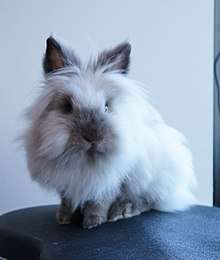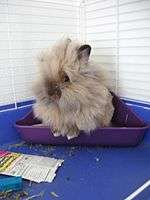Lionhead rabbit
Lionhead is a breed of domestic rabbit recognized by the British Rabbit Council (BRC)[1] and by the American Rabbit Breeders Association (ARBA).[2] The Lionhead rabbit has a wool mane encircling the head, reminiscent of a male lion as its name implies. Other Lionhead characteristics include a high head mount, compact upright body type, short well-furred 2- to 3-inch ears, and a weight of 2.5 to 3.75 pounds.

Shape
The Lionhead rabbit has a small, compact body, and the head is bold, yet not quite round from all sides, with well-developed muzzle. Their legs are of medium length and they are of medium bone. Their ears are not to exceed 3 inches long. Their mane is to be at least 2 inches long and is to form a full circle around the head, extending to a 'V' at the back of the neck. It may fall into a fringe between the ears, creating a "wool cap". Lionheads have a normal rollback coat of medium length over the saddle, and some have "transitional wool" on their flanks. Some Lionheads have noticeably longer wool on the cheeks and chest. Lionhead rabbits have outgoing personalities and are a popular pet in the United States.
History
The Lionhead rabbit originated in France and Belgium; although it is not recognised by the French Federation of Cuniculture. It is reported to have been produced by breeders trying to breed a long-coated dwarf rabbit by crossing a miniature Swiss Fox and a Netherland dwarf. This resulted in a genetic mutation causing wool to appear around the head and on the flanks. This gene has come to be known as the "mane" gene. There are many other reports similar to this, for example that the lionhead has been bred from a Netherland Dwarf and a Jersey Wooly, but none have been substantiated, since the mane gene is separate from the gene that creates wool coats in wooled rabbits. The Lionhead rabbit continued to gain popularity in Europe, and Lionheads found their way to the United States in the late 1990s.
In the United Kingdom, the BRC has recognized the Lionhead breed since 2002.
In 2013 the Lionhead was accepted as a recognized breed by ARBA in two varieties: Tortoise and Ruby-Eyed White.[3] As of 1 February 2014, Lionheads have been eligible to compete for Best in Show and to receive legs toward Grand Champion.
The North American Lionhead Rabbit Club (NALRC) holds its annual Lionhead Exhibition Specialty show in Columbus, Ohio. Typically, the Lionhead breed is represented by approximately 300-500 entries and 50-80 exhibitors from all over the United States and Canada.
Mane types

Typically, the mane is thick, woolly and soft with evident "crimping". Depending on the number of genes a Lionhead gets from each parent, it can have a double mane (two mane genes) or a single mane (one mane gene). The only way to tell if a rabbit is single mane or double mane is when it is first born. A double mane Lionhead will have a noticeable V form around their skirt/flanks, while a single mane will look like a common rabbit directly after birth. Past then, many factors contribute to how much mane each individual actually ends up having including chewing on the mane by themselves or others and matts.
Single maned
Single mane Lionhead rabbits only have one copy of the mane gene. These Lionheads typically do not hold a mane for their entire lifetime. They have a mane that can be around its head, ears, chin and sometimes on the chest and rump. The mane may be wispy and thin and may disappear on some rabbits altogether as they mature.
Single maned Lionheads are usually the product of a Purebred Double mane Lionhead being bred to a rabbit of another breed in order to strengthen a particular characteristic, or to introduce a particular color into the Lionhead breed. Kits born without a copy of the mane gene are called "no maned."
Double maned
Double maned Lionheads have two copies of the mane gene. They typically have a thick mane of wool encircling the head and sometimes have wool on their flanks that some refer to as a "skirt." A double maned lionhead is the product of either two single maned Lionheads (will have single manes in the litter) or two double maned lionheads.
Temperament
In most cases the Lionhead is a friendly and well mannered pet, although they can be quite skittish if they don't feel safe. It is possible to train a Lionhead as they are very smart creatures. They can comprehend certain orders like come, play, and eat. Clicker training is now becoming popular. Lionhead rabbits can be litter trained, and make suitable house rabbits. Like all rabbits, if the Lionhead is treated kindly and well handled, they make great family pets. As with all rabbits, Lionheads should be kept in pairs at the very least as they are very sociable creatures.
See also
References
| Wikimedia Commons has media related to Lionhead rabbit. |
- "Breed Standards 2016-2020" (PDF). The British Rabbit Council. Retrieved 8 February 2018.
- "ARBA Recognized Breeds". American Rabbit Breeders Association. Retrieved 8 February 2018.
- "Lionhead Breed Now Recognized by ARBA". www.petcha.com. Retrieved 2018-02-08.